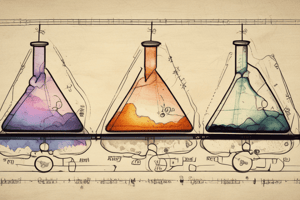Podcast
Questions and Answers
What is the overall heat of reaction for the process H2O(s) → H2O(g) if H2O(s) → H2O(l) gives 6.01 kJ/mol and H2O(l) → H2O(g) gives −44.0 kJ/mol?
What is the overall heat of reaction for the process H2O(s) → H2O(g) if H2O(s) → H2O(l) gives 6.01 kJ/mol and H2O(l) → H2O(g) gives −44.0 kJ/mol?
- −38.99 kJ/mol (correct)
- −37.5 kJ/mol
- −37.0 kJ/mol
- 49.0 kJ/mol
Which of the following correctly describes Hess’s Law?
Which of the following correctly describes Hess’s Law?
- Values of heat of reaction are fixed and do not depend on the reaction conditions.
- Hess's law only applies to reactions at high temperatures.
- The overall enthalpy change of a reaction is the same regardless of the number of steps. (correct)
- The heat of reaction is invariant regardless of the physical state of the substances involved.
What is the heat of reaction when converting solid water to liquid water?
What is the heat of reaction when converting solid water to liquid water?
- −6.01 kJ/mol
- 0 kJ/mol
- −12.02 kJ/mol
- 6.01 kJ/mol (correct)
Which statement about the heat of reaction is true?
Which statement about the heat of reaction is true?
What is the value of the standard enthalpy of formation for H2(g)?
What is the value of the standard enthalpy of formation for H2(g)?
If the reverse reaction H2O(l) → H2O(s) has a heat of reaction of −6.01 kJ/mol, what is the heat of reaction for the forward process?
If the reverse reaction H2O(l) → H2O(s) has a heat of reaction of −6.01 kJ/mol, what is the heat of reaction for the forward process?
Which of the following statements is false regarding thermochemical equations?
Which of the following statements is false regarding thermochemical equations?
Using the standard enthalpies of combustion provided, what is the enthalpy change for the combustion of propane (C3H8)?
Using the standard enthalpies of combustion provided, what is the enthalpy change for the combustion of propane (C3H8)?
What is the heat of reaction for the process H2O(g) → H2O(l)?
What is the heat of reaction for the process H2O(g) → H2O(l)?
The heat of reaction is an intensive property.
The heat of reaction is an intensive property.
According to Hess's Law, what is the relationship between the heat of a reaction and its individual steps?
According to Hess's Law, what is the relationship between the heat of a reaction and its individual steps?
The standard enthalpy change for forming one mole of a substance from its elements in standard state is called the standard ________ of formation.
The standard enthalpy change for forming one mole of a substance from its elements in standard state is called the standard ________ of formation.
Match the following thermochemical changes with their corresponding heat of reaction.
Match the following thermochemical changes with their corresponding heat of reaction.
What does Hess's Law indicate about enthalpy changes?
What does Hess's Law indicate about enthalpy changes?
The heat of reaction for the reverse process is always equal in magnitude to the forward process.
The heat of reaction for the reverse process is always equal in magnitude to the forward process.
What is the overall heat of reaction for the conversion of solid water to gas?
What is the overall heat of reaction for the conversion of solid water to gas?
The process of converting one mole of H2O(s) to H2O(g) involves two steps: H2O(s) → H2O(l) with ____ kJ/mol, and H2O(l) → H2O(g) with ____ kJ/mol.
The process of converting one mole of H2O(s) to H2O(g) involves two steps: H2O(s) → H2O(l) with ____ kJ/mol, and H2O(l) → H2O(g) with ____ kJ/mol.
Which of the following statements is true regarding thermochemical equations?
Which of the following statements is true regarding thermochemical equations?
Flashcards are hidden until you start studying
Study Notes
Thermochemical Equations
- A thermochemical equation includes the enthalpy change of the reaction
- The physical state of reactants and products affects the heat of reaction
- The heat of reaction is an extensive property - doubling the amount of a reactant or product doubles the heat of reaction
- The magnitude of the heat of reaction for a reverse process is equal to the forward reaction but opposite in sign
Hess's Law of Heat Summation
- The overall heat of reaction for a multi-step process is the sum of the heats of reaction for the individual steps
- This law holds true because enthalpy is a state function, meaning the total enthalpy change is independent of the path taken
Standard Enthalpy of Formation
- The enthalpy change that occurs when one mole of a substance is formed in its standard state from its elements in their standard states
Thermochemical Equation
- A thermochemical equation is a chemical equation that includes the enthalpy change of the reaction.
- The enthalpy change (∆H) indicates whether the reaction is exothermic (releases heat, negative ∆H) or endothermic (absorbs heat, positive ∆H).
Important Considerations for Thermochemical Equations
- Physical State: The heat of reaction depends on the physical state (solid, liquid, or gas) of both reactants and products.
- Extensive Property: The heat of reaction is an extensive property, meaning it is proportional to the amount of reactants involved. Doubling the amount of reactants doubles the heat of reaction.
- Reverse Process: The magnitude of the heat of reaction for a reverse process is equal to the forward reaction, but the sign is opposite.
Hess's Law of Heat Summation
- Hess's Law states that if a chemical reaction is carried out in multiple steps, the overall enthalpy change of the reaction is the sum of the enthalpy changes for each individual step.
- Regardless of the steps involved, the total enthalpy change remains the same.
- This additivity property is due to enthalpy being a state function.
Example 1: Calculating Enthalpy Change with Hess's Law
- Overall Reaction: H2O(s) → H2O(g)
- Step 1: H2O(s) → H2O(l) (∆H = 6.01 kJ/mol)
- Step 2: H2O(l) → H2O(g) (∆H = -44.0 kJ/mol)
- To calculate the overall enthalpy change (∆H), sum the enthalpy changes from each step: ∆H = 6.01 kJ/mol + (-44.0 kJ/mol) = -38.0 kJ/mol
Example 2: Combustion Reactions and Enthalpy Change
- Combustion Reactions: The standard enthalpies of combustion are provided for C(graphite), H2(g), and C3H8(g).
- Goal: Using Hess's Law, calculate the standard enthalpy change for the reaction: C(graphite) + 2H2(g) → C3H8(g)
- Step 1: Write the combustion reactions for each reactant and the product:
- C(graphite) + O2(g) → CO2(g) (∆H = -393.5 kJ/mol)
- H2(g) + 1/2O2(g) → H2O(l) (∆H = -285.8 kJ/mol)
- C3H8(g) + 5O2(g) → 3CO2(g) + 4H2O(l) (∆H = -2219.9 kJ/mol)
- Step 2: Manipulate the equations to match the overall reaction.
- Step 3: Sum the enthalpy changes for each step to find the overall enthalpy change for the reaction
Standard enthalpy of formation
- The standard enthalpy of formation refers to the enthalpy change that occurs when one mole of a substance in its standard state is formed from its elements in their standard states.
- Standard state usually means 298 K (25 °C) and 1 atm pressure.
Studying That Suits You
Use AI to generate personalized quizzes and flashcards to suit your learning preferences.




